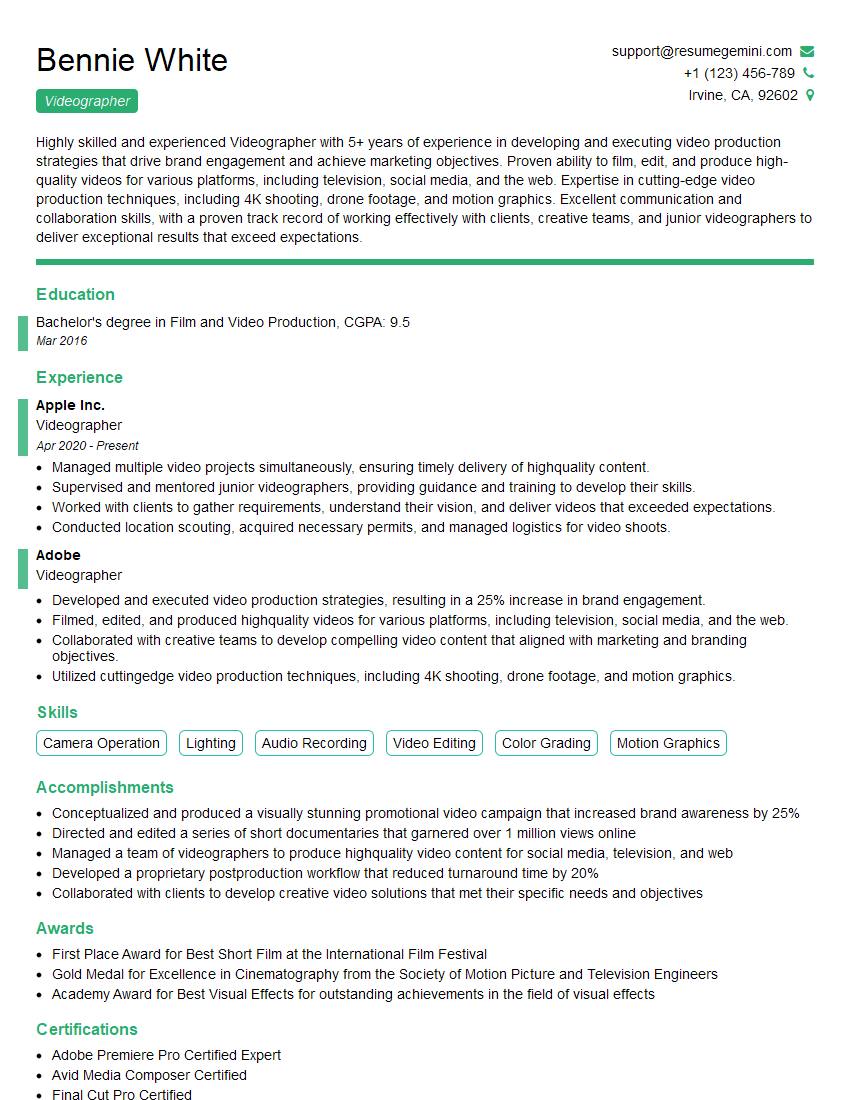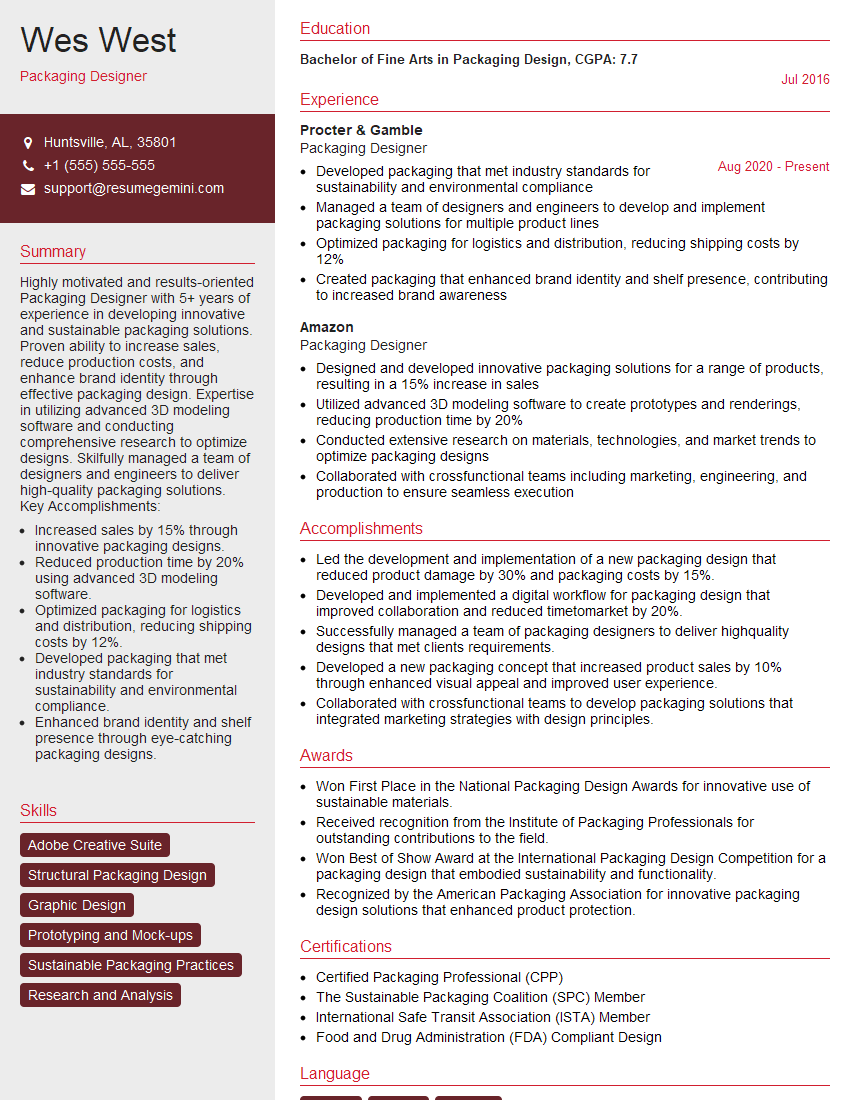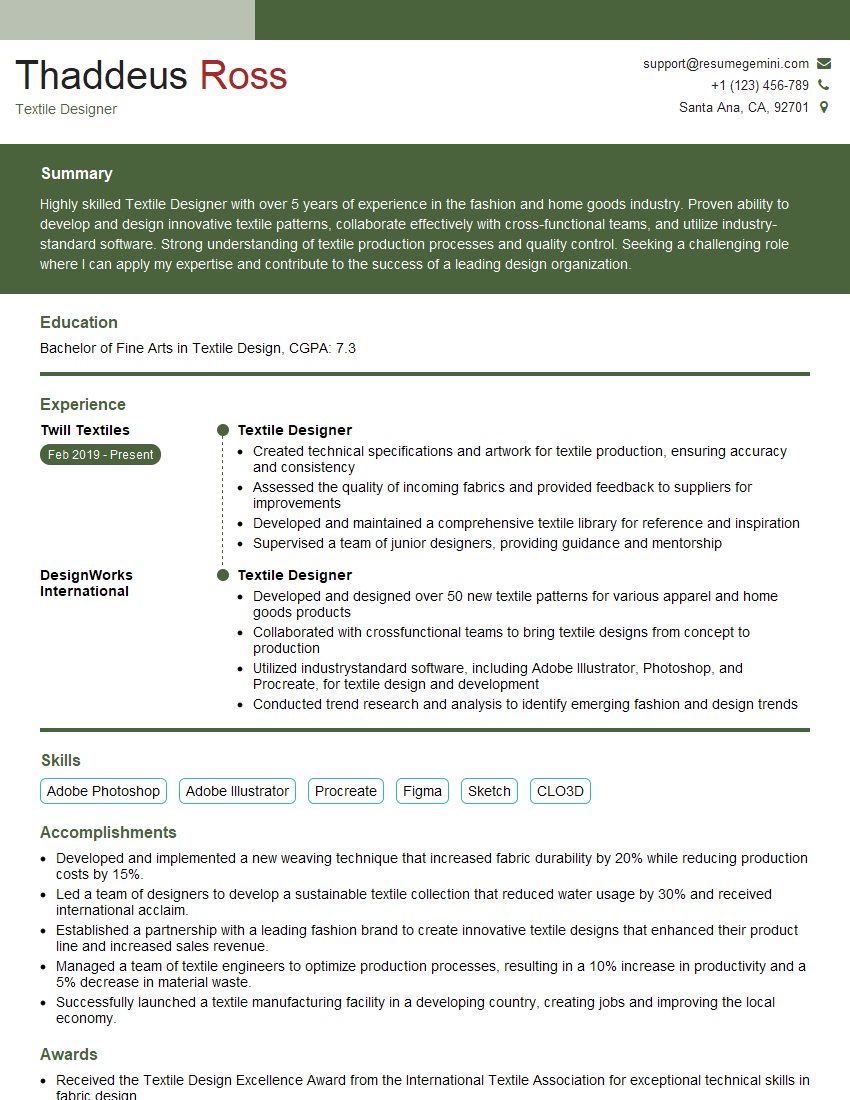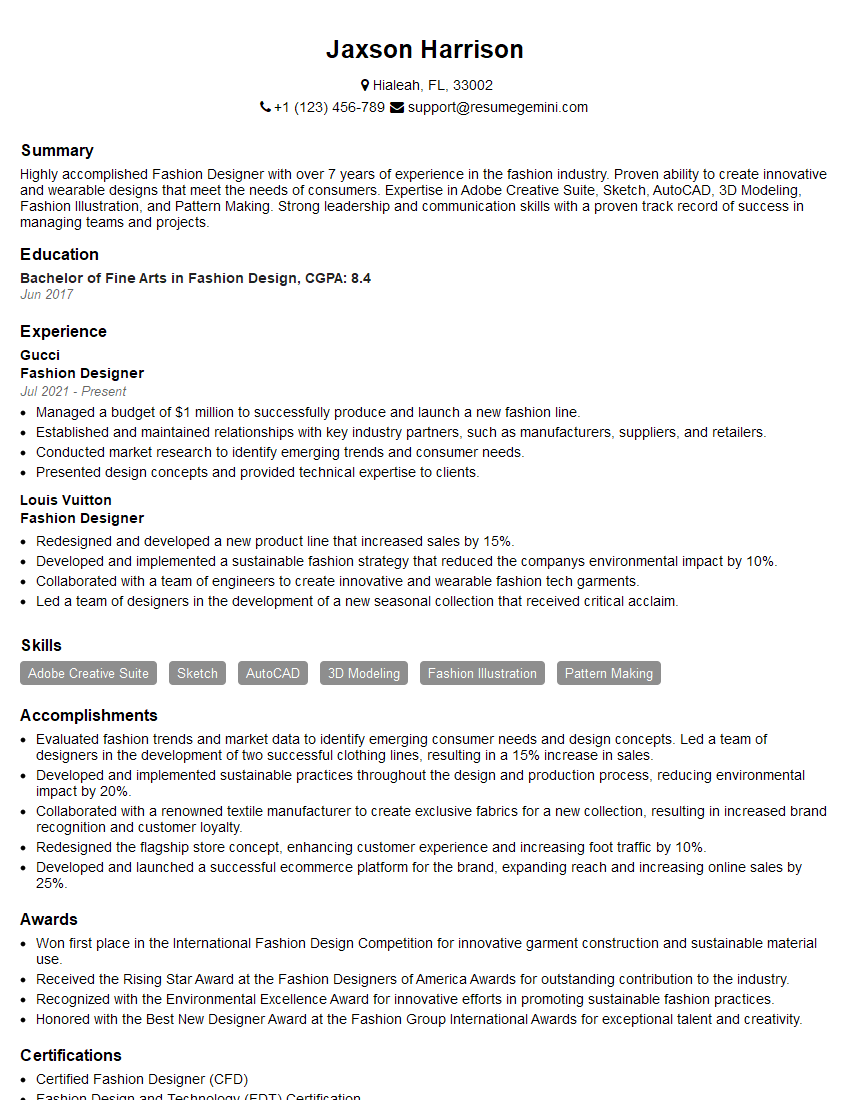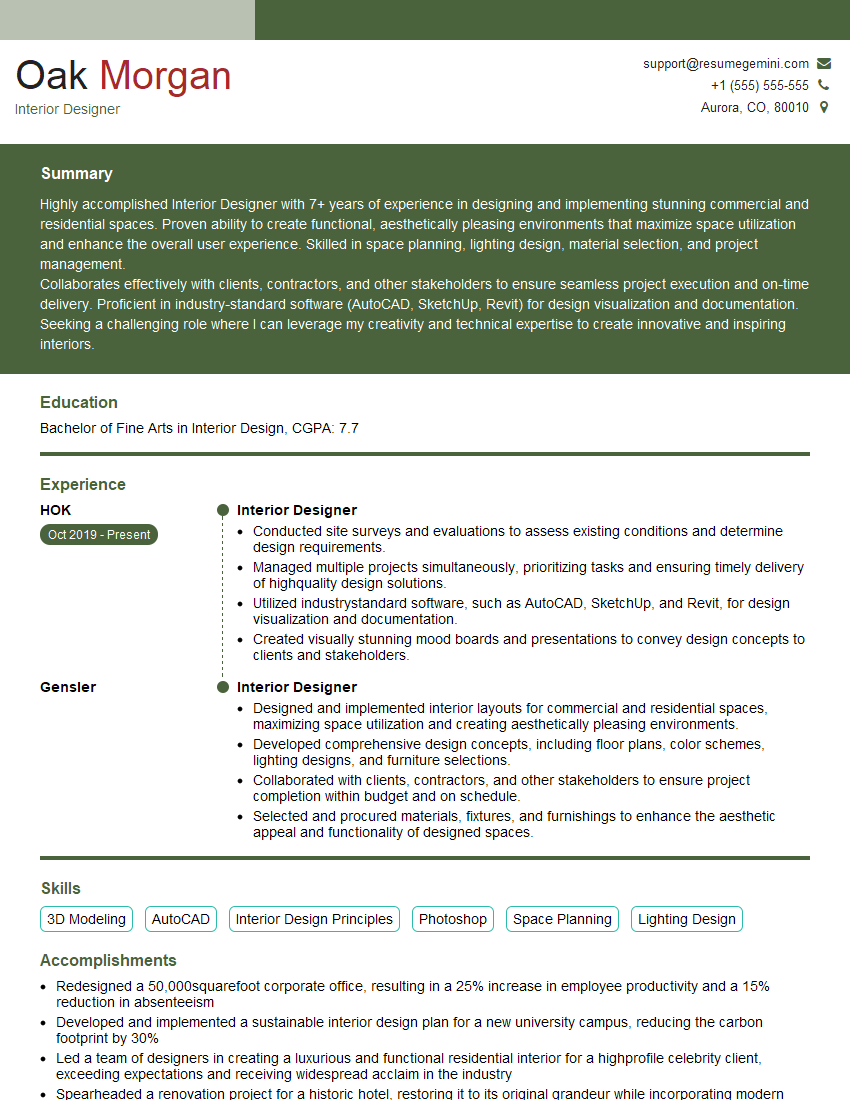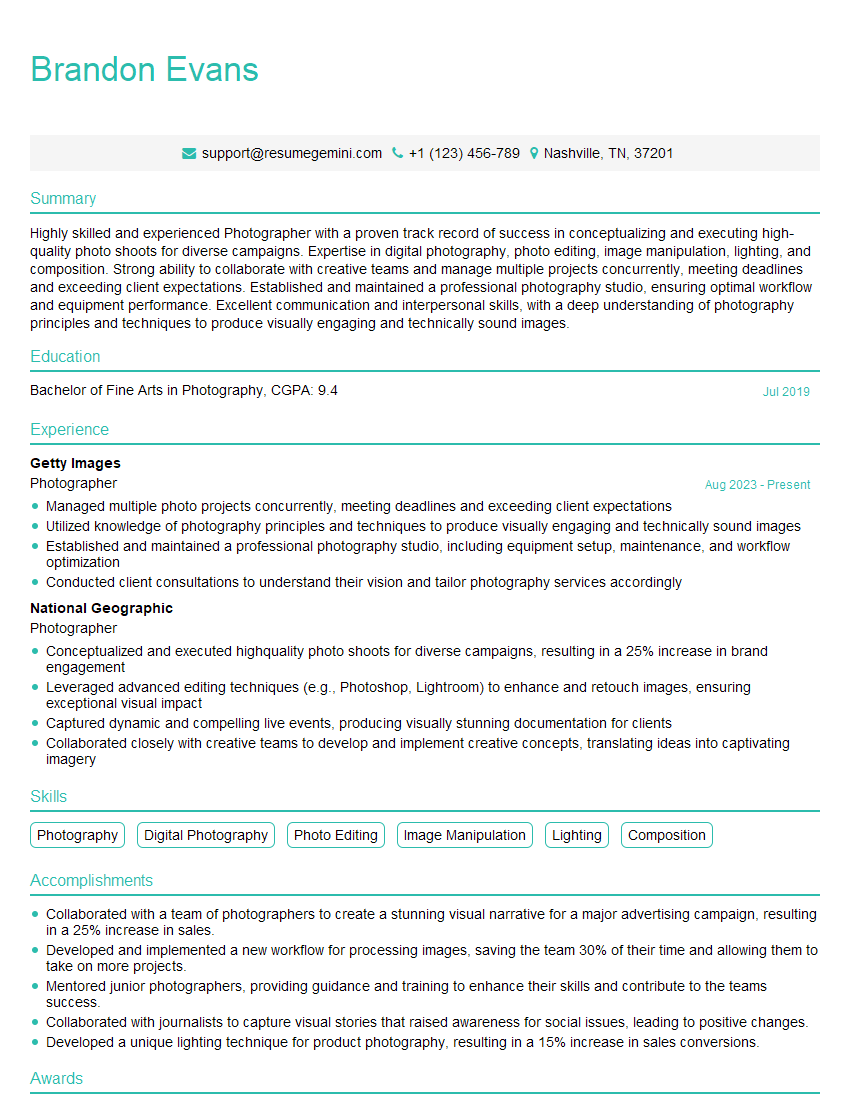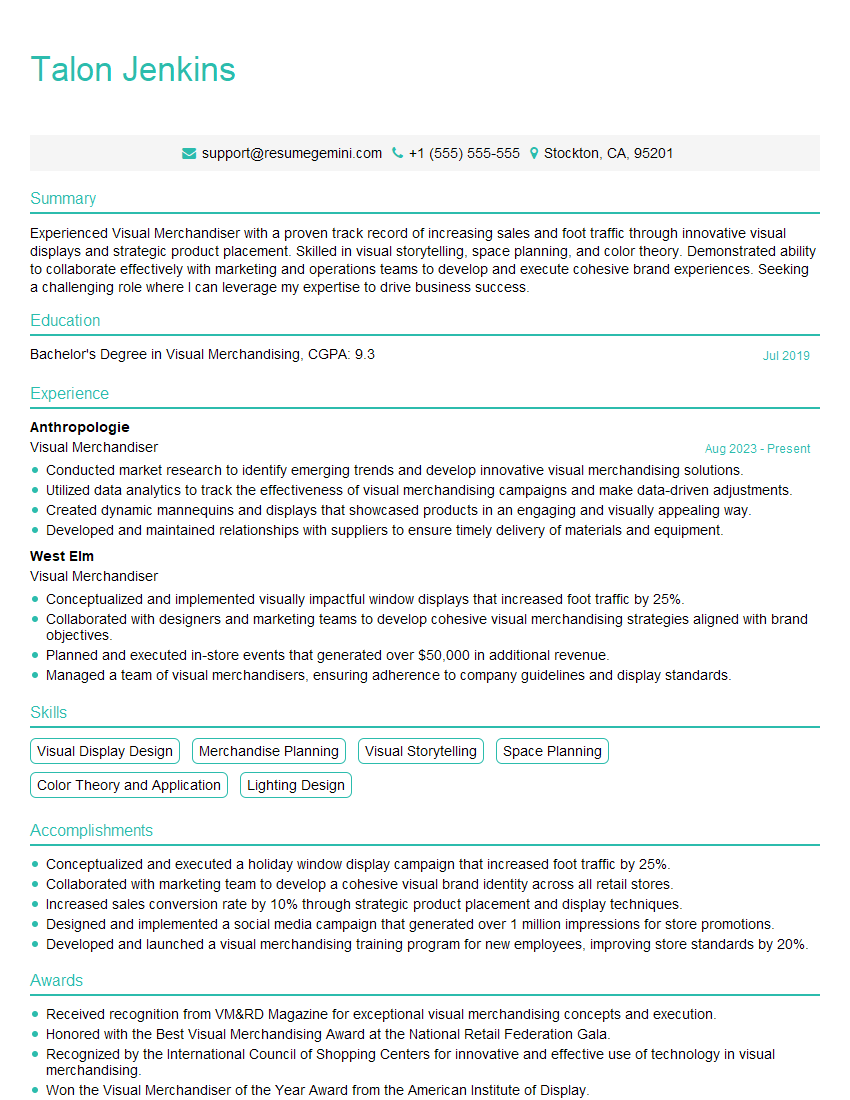The thought of an interview can be nerve-wracking, but the right preparation can make all the difference. Explore this comprehensive guide to Color Theory and Principles interview questions and gain the confidence you need to showcase your abilities and secure the role.
Questions Asked in Color Theory and Principles Interview
Q 1. Explain the difference between additive and subtractive color mixing.
Additive and subtractive color mixing are two fundamentally different approaches to creating colors. Think of it like this: additive is about adding light, while subtractive is about subtracting light.
Additive color mixing is what happens when we mix colored lights, like on a computer screen or TV. The primary colors are red, green, and blue (RGB). When you combine these primary colors at full intensity, you get white light. As you reduce the intensity of each color, you move towards darker shades, ultimately reaching black when all colors are absent. This is because each color contributes to the overall light intensity.
Subtractive color mixing occurs when we mix pigments or inks, like paints or dyes. The primary colors here are cyan, magenta, and yellow (CMY). These colors absorb specific wavelengths of light and reflect others, creating the color we see. Combining all three primary colors ideally results in black (though true black often requires the addition of a fourth color, key (K) – to form CMYK).
In essence, additive mixing is about light emission, while subtractive is about light reflection and absorption. The same color will appear differently depending on the mixing method. For instance, mixing red and green light additively yields yellow, while mixing red and green pigments subtractively yields a muddy brown.
Q 2. Describe the RYB and RGB color models. What are their applications?
RYB (Red, Yellow, Blue) is a traditional color model primarily used in the context of pigments. It’s the color model most of us learned in art class as children. While it’s intuitive for mixing paints, it doesn’t accurately reflect the way light behaves, making it less suitable for digital applications. Its applications are largely limited to painting, drawing, and other subtractive color mixing methods.
RGB (Red, Green, Blue) is an additive color model, fundamental to digital displays, like computer monitors and televisions. It works by combining red, green, and blue light to produce a wide range of colors. Each color is represented by a numerical value (typically 0-255 for each component), allowing for precise color control. Its applications are widespread in graphic design, web design, video production, photography, and any digital medium that relies on light emission.
Consider a digital artist creating a painting. They will likely use RGB in their digital painting software, but then need to translate the color scheme for printing – often into the CMYK space – which can lead to some differences in final color appearances.
Q 3. What is the color wheel and how is it used in design?
The color wheel is a visual representation of color relationships, typically arranged in a circle. It’s a crucial tool for understanding color harmony and choosing effective color schemes. A basic color wheel showcases the primary, secondary, and tertiary colors, derived from additive (RGB) or subtractive (RYB or CMYK) color models. Each color is positioned according to its hue and relationship to other colors.
In design, the color wheel helps designers:
- Choose harmonious color palettes: The wheel visually demonstrates complementary, analogous, triadic, and other color schemes.
- Understand color temperature: Warm colors (reds, oranges, yellows) are typically placed on one side, while cool colors (blues, greens, purples) are on the other.
- Create visual hierarchy and emphasis: Using contrasting colors or colors with varying levels of saturation can draw the eye to specific elements in a design.
- Maintain brand consistency: A well-defined color palette, created with the help of a color wheel, ensures a unified and memorable brand identity.
Imagine a website designer using the color wheel to choose a calming palette for a spa website: they would likely select shades of blues and greens. On the other hand, a designer working on a gaming site might opt for a more vibrant palette with contrasting colors for maximum impact.
Q 4. Explain the concept of color harmony. Give examples of different harmonies.
Color harmony refers to the pleasing arrangement of colors in a design. It’s about creating visual appeal and balance through the thoughtful selection and combination of colors. Harmonious color schemes evoke specific moods and feelings and improve the overall aesthetics of a design. Dissonance, conversely, is the unpleasant clash of colors.
Examples of different harmonies:
- Complementary: Colors directly opposite each other on the color wheel (e.g., red and green, blue and orange). They create high contrast and visual excitement.
- Analogous: Colors that are adjacent to each other on the color wheel (e.g., blue, blue-green, green). They create a calm and serene feeling.
- Triadic: Three colors evenly spaced on the color wheel (e.g., red, yellow, blue). They offer a vibrant and balanced look.
- Tetradic (double complementary): Two sets of complementary color pairs. These combinations allow for high contrast while still maintaining balance and visual unity.
- Monochromatic: Different shades, tints, and tones of a single color. This produces a sleek, cohesive look, commonly seen in logos or branding.
A logo designer might use a complementary color scheme for high impact, while a painter might prefer analogous colors for a peaceful landscape.
Q 5. Define analogous, complementary, triadic, and split-complementary color schemes.
These are specific types of color harmonies, all easily visualized on the color wheel:
- Analogous: Colors sitting next to each other on the color wheel. They share a common hue and create a sense of calmness and harmony. Example: Blue-green, green, and yellow-green.
- Complementary: Colors directly opposite each other on the color wheel. They create high contrast and visual excitement. Example: Red and green, blue and orange.
- Triadic: Three colors evenly spaced on the color wheel. They provide a balanced and vibrant combination. Example: Red, yellow, and blue.
- Split-complementary: A base color and the two colors adjacent to its complement. It offers a good balance between harmony and contrast. Example: Blue as the base, with orange-yellow and red-orange.
Q 6. How do you create a color palette for a specific project?
Creating a color palette for a project is a systematic process. Here’s a step-by-step approach:
- Define the project’s purpose and target audience: What feeling or message do you want to convey? Who are you designing for? This will heavily influence your color choices.
- Mood board and inspiration: Gather inspiration – images, textiles, nature – to visually define the desired mood and aesthetic.
- Choose a base color: Select a dominant color that reflects the project’s core message. This could be a brand color or a color inspired by your mood board.
- Select supporting colors: Use the color wheel to choose colors that harmoniously complement your base color, considering the color harmony types discussed previously.
- Adjust saturation and brightness: Experiment with different shades, tints, and tones of your chosen colors to achieve the desired level of contrast and visual interest.
- Test and iterate: Apply your palette to mockups or prototypes and evaluate its effectiveness. Make adjustments as needed until you’re satisfied.
- Document your palette: Record the exact hex codes or RGB values for consistent use throughout the project.
For instance, if I were designing a website for a sustainable clothing brand, my base color might be a deep green, and I’d use analogous colors like olive green and teal for a natural and calming feel.
Q 7. Explain the importance of color temperature in design.
Color temperature refers to the warmth or coolness of a color, often described as ranging from warm (yellowish, reddish hues) to cool (bluish, greenish hues). It significantly impacts the mood and atmosphere of a design.
Warm colors evoke feelings of energy, excitement, comfort, and friendliness. They tend to advance visually, appearing closer to the viewer. Think of a cozy fireplace or a sunny beach.
Cool colors evoke feelings of calmness, serenity, professionalism, and trustworthiness. They visually recede, creating a sense of space and depth. Think of a clear winter sky or a calm ocean.
In design, understanding color temperature is crucial for:
- Setting the mood: Warm colors are often used for inviting spaces, while cool colors are ideal for calming environments.
- Creating visual hierarchy: Warm colors can be used to draw attention to key elements, while cool colors can create a sense of background or secondary focus.
- Balancing compositions: Using both warm and cool colors effectively can create visual harmony and depth.
A website for a fast food restaurant might use warm colors to stimulate appetite, while a website for a meditation app would probably utilize cool colors to project calm.
Q 8. Discuss the psychological impact of different colors.
Color psychology explores the effects of different colors on human emotions, behavior, and perceptions. It’s a powerful tool because colors evoke specific feelings and associations almost universally, though cultural nuances exist.
- Warm Colors (Reds, Oranges, Yellows): These are often associated with energy, excitement, warmth, and even aggression. Red, for example, can stimulate appetite (think fast-food logos) but also trigger feelings of urgency or danger (stop signs).
- Cool Colors (Blues, Greens, Purples): These colors tend to evoke feelings of calmness, serenity, trust, and stability. Blue is often used to project professionalism and trustworthiness, while green is associated with nature and growth.
- Neutral Colors (Whites, Grays, Blacks, Browns): These colors are less emotionally charged but offer versatility. White conveys cleanliness and simplicity, black represents sophistication and power, gray implies neutrality and balance, and brown suggests earthiness and reliability.
Understanding color psychology allows designers to carefully craft the mood and message of a space or product. For example, a hospital might use calming blues and greens to soothe patients, while a fast-food restaurant might utilize vibrant reds and yellows to encourage faster eating.
Q 9. How does color affect branding and marketing?
Color is a cornerstone of branding and marketing, profoundly impacting how a brand is perceived. Consistent use of specific colors creates brand recognition and builds emotional connections with consumers.
- Brand Identity: Colors communicate brand personality. A technology company might use blues and grays to project innovation and dependability, while a playful children’s brand might opt for bright, cheerful colors.
- Marketing Campaigns: Color choices influence consumer behavior. Using a specific color consistently across marketing materials (website, social media, print ads) reinforces brand identity and improves memorability.
- Emotional Response: Marketing leverages color psychology to evoke desired emotions. A sale might use red to indicate urgency, while a luxury brand might use deep blues or gold to suggest exclusivity.
For instance, Coca-Cola’s iconic red is instantly recognizable worldwide and associated with happiness and refreshment. This demonstrates the power of strategic color use in building a strong, memorable brand.
Q 10. How do you ensure color consistency across different mediums (print, web, etc.)?
Maintaining color consistency across different mediums requires a meticulous approach, involving careful selection of color profiles and formats.
- Color Management System (CMS): Implementing a CMS is crucial for managing and controlling colors throughout the entire design workflow. This ensures that colors remain consistent regardless of the output medium.
- Color Space: Understanding color spaces (RGB for screens, CMYK for print) is key. RGB values are additive; CMYK values are subtractive, meaning colors appear differently on screen versus in print. Conversion needs careful calibration.
- Proofing: Always proof your work using the intended output method (e.g., printing a test print for print materials). This helps catch color discrepancies early.
- Pantone Matching System (PMS): Using Pantone colors (discussed in detail below) provides a universal color language, allowing for precise color matching across various mediums.
Ignoring these steps can lead to significant variations in color, impacting the overall brand aesthetic and project quality. For example, a logo appearing vibrant on screen might look dull and washed out in print if the correct CMYK values are not used.
Q 11. Explain the concept of color saturation and value.
Color saturation and value are two essential attributes that define the overall appearance of a color. They work together to create the full spectrum of color possibilities.
- Saturation (Chroma): This refers to the intensity or purity of a color. A highly saturated color is vibrant and rich, while a low-saturated color appears dull or muted (think pastel shades).
- Value (Brightness/Lightness): This refers to the lightness or darkness of a color. It’s often represented on a scale from black (low value) to white (high value). Adding white increases the value, creating a tint; adding black lowers the value, creating a shade.
Understanding saturation and value is critical for creating visually appealing and balanced designs. For example, using highly saturated colors throughout a design can be overwhelming, while using only low-saturation colors might result in a bland design. A balanced approach often involves a range of saturation and values to create visual interest.
Q 12. What are Pantone colors and how are they used?
Pantone colors are a standardized color matching system. Pantone produces a color book with a numbered collection of standardized colors, each with a unique formula and identification number. This allows designers, printers, and manufacturers to specify and reproduce colors consistently, regardless of the medium or printing process.
- Consistency: The primary benefit is color consistency. Specifying a Pantone color ensures everyone involved (designer, printer, manufacturer) is working with the same color, reducing discrepancies.
- Precise Color Matching: Pantone provides a universal language for color. Instead of relying on subjective color names, you have a precise numerical reference (e.g., Pantone 18-1664 TPX).
- Brand Protection: Maintaining consistent brand colors across all materials is critical for brand identity and recognition. Pantone plays a crucial role in achieving this.
Many brands rely heavily on Pantone for their logo and brand colors, ensuring consistent reproduction on everything from business cards to billboards. For example, Tiffany & Co.’s iconic robin’s egg blue is a precise Pantone color, helping maintain its unique visual identity.
Q 13. Describe your understanding of color accessibility and WCAG guidelines.
Color accessibility focuses on ensuring that color choices do not exclude users with visual impairments, particularly those with color blindness. WCAG (Web Content Accessibility Guidelines) provides standards for creating accessible digital content. These guidelines address color contrast, ensuring sufficient difference between foreground and background colors for readability.
- Color Contrast Ratios: WCAG defines minimum contrast ratios between text and background colors to ensure readability. These ratios vary depending on the text size and weight.
- Color Blindness Simulation: Tools and techniques are available to simulate different types of color blindness, allowing designers to check if their color choices remain legible to all users.
- Beyond Color: Relying solely on color to convey information isn’t good practice. Use visual cues in conjunction with color, for example, using text labels along with color-coded elements.
Failing to consider color accessibility can severely restrict access to information for a significant portion of the population. Checking contrast ratios and employing alternative visual cues ensures inclusivity and a better user experience.
Q 14. How do you manage color conflicts in a design project?
Color conflicts in a design project can stem from poor color choices, inconsistencies, or clashing color palettes. Addressing them involves a systematic approach.
- Color Palette Review: Start by reviewing the chosen color palette. Determine if the colors clash or create visual disharmony. Use color harmony rules (complementary, analogous, etc.) as a guide.
- Contrast Check: Verify contrast ratios. Ensure sufficient contrast between text and backgrounds for readability. Use contrast checking tools.
- Saturation Adjustment: Lowering the saturation of conflicting colors can help reduce visual tension. This can soften the impact of overly vibrant colors.
- Value Adjustment: Modify the values (lightness/darkness) of colors to create a more balanced composition. For example, darkening a background color can enhance text readability.
- Color Substitution: If necessary, consider substituting clashing colors with more harmonious alternatives.
Resolving color conflicts is an iterative process, requiring testing and adjustments until a visually pleasing and functional design is achieved. Tools like color wheels and online color palette generators are helpful resources.
Q 15. Explain your process for selecting a color palette for a website.
Selecting a color palette for a website is a crucial process that involves understanding the brand, target audience, and desired user experience. My process is iterative and involves several key steps:
- Understanding the Brief: I begin by thoroughly understanding the client’s brand guidelines, target audience, and the website’s purpose. What feeling should the website evoke? What is the brand’s personality? For example, a website for a luxury brand will require a completely different palette than a website for a children’s toy company.
- Mood Board Creation: I then create a mood board, gathering images and textures that reflect the desired aesthetic. This helps visualize the overall feel and informs color choices. This might include images from nature, existing branding materials, or even artwork that inspires the project.
- Color Exploration: I use color tools like Adobe Color or Coolors to explore different color harmonies. I experiment with analogous, complementary, triadic, and tetradic schemes, considering the psychological impact of each color. For instance, blues are often calming, while reds can evoke excitement.
- Testing and Iteration: I create several palette options and test them in different contexts, considering both light and dark modes. I also look at how the colors work together with typography and imagery. Feedback from the client is crucial at this stage.
- Accessibility Considerations: Finally, I ensure the chosen palette meets accessibility guidelines, providing sufficient contrast between text and background for readability. Tools like WebAIM’s contrast checker are invaluable here.
This structured approach ensures a well-rounded palette that supports the website’s goals and provides a positive user experience.
Career Expert Tips:
- Ace those interviews! Prepare effectively by reviewing the Top 50 Most Common Interview Questions on ResumeGemini.
- Navigate your job search with confidence! Explore a wide range of Career Tips on ResumeGemini. Learn about common challenges and recommendations to overcome them.
- Craft the perfect resume! Master the Art of Resume Writing with ResumeGemini’s guide. Showcase your unique qualifications and achievements effectively.
- Don’t miss out on holiday savings! Build your dream resume with ResumeGemini’s ATS optimized templates.
Q 16. What are some common color pitfalls to avoid in design?
Several common color pitfalls can significantly hinder a design’s effectiveness. Here are a few key ones to avoid:
- Poor Contrast: Insufficient contrast between text and background makes the website nearly unreadable, especially for users with visual impairments. Always use a contrast checker to ensure adequate contrast ratios.
- Overusing Colors: A chaotic palette with too many colors can overwhelm the user and dilute the brand’s message. Sticking to a limited palette, typically 3-5 core colors, leads to a more cohesive and professional look.
- Ignoring Color Psychology: Using colors inappropriately can send the wrong message. For example, using bright red for a website promoting relaxation would be counterintuitive.
- Neglecting Accessibility: Color choices must cater to users with color blindness. Ensure sufficient contrast and avoid relying solely on color to convey information.
- Ignoring the Context: The same color can appear differently on various screens and devices due to variations in display settings. Always test your palette across different devices and browsers.
By avoiding these pitfalls, designers create visually appealing and user-friendly websites that effectively communicate their message.
Q 17. How would you use color to evoke a specific emotion or feeling?
Color is a powerful tool for evoking emotions and feelings. Understanding color psychology is crucial for achieving the desired emotional response.
- Warm Colors (Reds, Oranges, Yellows): These colors generally evoke feelings of energy, excitement, warmth, and sometimes aggression. A website for a fast-food restaurant might leverage these colors.
- Cool Colors (Blues, Greens, Purples): These colors often create a sense of calm, peace, trust, and serenity. A website for a spa or meditation app would benefit from a cool palette.
- Neutral Colors (Whites, Grays, Blacks): These colors provide a sense of balance and sophistication, serving as a great backdrop for other colors or to create a minimalist aesthetic. They can be used to create a feeling of neutrality or even elegance depending on their use.
It’s important to remember that the emotional impact of color is subjective and can also be influenced by cultural context. However, a general understanding of color psychology provides a strong starting point for using color to evoke specific feelings in your design.
Q 18. Explain the use of color in creating visual hierarchy.
Visual hierarchy uses color to guide the user’s eye and emphasize key elements. It directs attention to important information and creates a clear reading path.
For example, a website’s primary call to action (e.g., a ‘Buy Now’ button) might be highlighted with a contrasting, bold color that draws the user’s immediate attention. Secondary elements can be emphasized with slightly less saturated colors, while background elements use muted or neutral tones. This creates a clear visual flow and improves the user experience.
Consider a website for an e-commerce store: The product images might use vibrant colors, while the navigation menu uses a softer, more neutral tone. The ‘Add to Cart’ button would pop with a bright, attention-grabbing color.
Q 19. Discuss the importance of considering different screen resolutions when selecting colors.
Different screen resolutions significantly impact color appearance. Colors that look vibrant on a high-resolution monitor might appear dull or washed out on a lower-resolution screen. This is due to variations in pixel density and color gamut.
To address this, designers must carefully calibrate their color palettes and test them across various devices and resolutions. Color management software is also critical, ensuring consistency regardless of display technology. It is important to use color profiles that maintain the accuracy of colors across all platforms. Using standard color spaces such as sRGB helps in ensuring colors are displayed as intended across a range of displays.
Q 20. How do you translate a client’s vision into a cohesive color scheme?
Translating a client’s vision into a cohesive color scheme requires active listening, clear communication, and a deep understanding of color theory.
- Active Listening: I start by carefully listening to the client’s description of their vision, paying close attention to their use of adjectives and metaphors. Are they aiming for a ‘modern and sleek’ or a ‘rustic and warm’ feel?
- Visual References: I encourage clients to provide visual references such as websites, logos, or even photographs that capture the desired aesthetic. These references act as invaluable tools to translate abstract ideas into concrete color palettes.
- Collaborative Exploration: I present several color palette options based on the client’s input and my expertise in color theory. We collaboratively refine these options, discussing the strengths and weaknesses of each palette.
- Iterative Refinement: The process is iterative, involving multiple rounds of feedback and adjustments. I create mockups and present them to the client, allowing for real-time evaluation and refinement.
This collaborative approach ensures that the final color scheme aligns perfectly with the client’s vision while also leveraging my expertise to ensure its effectiveness and aesthetic appeal.
Q 21. Describe your experience with color management software (e.g., Adobe Color, Pantone Connect).
I have extensive experience with color management software such as Adobe Color and Pantone Connect. Adobe Color allows for exploring various color harmonies, creating and saving palettes, and generating CSS code for easy implementation.
Pantone Connect, on the other hand, is invaluable for ensuring color consistency across different mediums. Its extensive Pantone library ensures that colors selected are reproducible accurately in print and digital formats. This is particularly useful for maintaining brand consistency across different marketing materials and digital properties. Both tools are vital for maintaining color accuracy and ensuring a consistent brand identity across all platforms. I routinely utilize them to both develop and manage color palettes in various projects.
Q 22. How do you handle color-blindness considerations in your designs?
Addressing color blindness in design is crucial for inclusivity. Many people experience some form of color vision deficiency, most commonly red-green color blindness. My approach involves several strategies:
- Using color palettes tested for color blindness: I utilize tools and online simulators that preview designs as they would appear to individuals with various types of color blindness. This allows me to identify potential issues early on.
- Prioritizing sufficient color contrast: Beyond just choosing colors, I ensure that there’s enough contrast between foreground and background elements. Tools like WebAIM’s contrast checker help meet WCAG (Web Content Accessibility Guidelines) standards, guaranteeing readability for everyone.
- Reliance on multiple visual cues: Color shouldn’t be the sole means of conveying information. I supplement color with patterns, shapes, text labels, and other visual elements to ensure accessibility even for those who can’t distinguish certain colors. For example, using different patterns alongside colors for interactive elements.
- Choosing color combinations carefully: I avoid using color combinations known to be problematic for people with color vision deficiencies, such as red and green together for crucial information.
By employing these methods, I strive to create designs that are accessible and enjoyable for all users, regardless of their visual capabilities.
Q 23. How does color impact user experience (UX)?
Color profoundly impacts user experience. It evokes emotions, guides attention, and establishes brand identity. The psychology of color is a powerful tool.
- Emotional Response: Warm colors like red and orange often stimulate excitement and energy, while cool colors such as blue and green tend to evoke calmness and trust. Consider how a website using predominantly red might feel different from one using blue.
- Visual Hierarchy: Color helps establish a visual hierarchy, guiding the user’s eye to important elements. A bright, contrasting color can draw immediate attention to a call to action button, while less saturated colors can be used for secondary information.
- Brand Identity: Color is integral to brand recognition. Think of the instantly recognizable colors of major brands like Coca-Cola (red) or Tiffany & Co. (robin’s egg blue). Consistent use of brand colors across all platforms enhances brand recall and user recognition.
- Readability and Usability: Proper color contrast ensures text is easily readable. Poor contrast can lead to eye strain and frustrate users. Similarly, color can be used to highlight interactive elements, making it clear what is clickable or selectable.
Understanding and strategically applying these principles ensures a positive and intuitive user experience.
Q 24. Explain the use of color in creating a sense of depth or space.
Creating a sense of depth and space with color is based on principles of atmospheric perspective and how our eyes perceive distance.
- Atmospheric Perspective: This involves using lighter, less saturated colors for objects farther away and darker, more saturated colors for objects closer to the viewer. Think of a landscape painting where the mountains in the distance appear hazy and bluish, while the foreground is rich and detailed.
- Color Temperature: Warm colors (reds, oranges, yellows) tend to appear closer, while cool colors (blues, greens, purples) recede into the background. This is because warm colors are associated with light sources and appear to advance, while cool colors mimic shadows and appear to recede.
- Value and Saturation: Lowering the value (making it lighter) and saturation of a color makes it visually recede, while increasing the value and saturation brings it forward. This is especially effective when used in conjunction with color temperature.
- Layering and Overlap: Overlapping elements and using color to indicate which element is in front of another can also create depth. For instance, using a slightly darker and more saturated color for an object in the foreground to give it prominence over an object in the background.
By mastering these techniques, designers can create a sense of three-dimensionality and spaciousness within a two-dimensional design.
Q 25. What is your preferred method for communicating color choices to clients or colleagues?
Communicating color choices effectively is paramount. My preferred method combines visual tools with clear explanations.
- Mood Boards and Color Palettes: I create visual mood boards using platforms like Pinterest or Adobe Color, showcasing the chosen color palette and its inspiration. This allows clients to see the overall aesthetic and feel of the color scheme.
- Color Codes: Providing precise color codes (hex codes, RGB, CMYK) ensures accuracy and consistency across different platforms and software. I include these codes in well-organized documents.
- Printed Samples: For projects where color accuracy is critical (such as print design), I provide printed samples showing the exact colors used. This helps avoid discrepancies between screen and print representations.
- Clear Explanations: I always accompany visual representations with written explanations, detailing the rationale behind color choices, their emotional impact, and how they relate to the overall design goals and brand identity. I aim for clear, non-technical language whenever possible, adjusting my terminology based on the client’s level of design knowledge.
This multi-faceted approach ensures that everyone is on the same page regarding the color scheme, avoiding misunderstandings and ensuring a shared vision.
Q 26. How would you explain the concept of color to someone without design experience?
Imagine color as the language of light. Light waves of different lengths are interpreted by our eyes as different colors. Just like letters form words, and words form sentences, colors combine to create visual stories and experiences.
We perceive color based on its:
- Hue: This is the pure color—red, blue, green, etc. Think of it like the base color in a paint palette.
- Saturation: This refers to the intensity or purity of a color. A highly saturated color is vibrant, while a less saturated color is muted or pastel.
- Value/Brightness: This refers to the lightness or darkness of a color. A high-value color is light, while a low-value color is dark.
Combining these elements creates a vast spectrum of colors, each capable of evoking different emotions and conveying various meanings. Understanding how these components interact is key to using color effectively in any context.
Q 27. Describe a time you had to troubleshoot a color-related issue. What was your approach?
During a website redesign, the client’s brand guidelines specified a specific Pantone color for their logo. However, when we implemented the color on the website, it appeared significantly different on different screens and devices. This was a critical issue, as inconsistencies could damage brand identity.
My troubleshooting approach was systematic:
- Color Profile Verification: First, I meticulously verified the color profile used for the logo and ensured consistency in all software used for design and development.
- Testing Across Devices: I thoroughly tested the website’s appearance on various devices with different screen resolutions and color settings. This helped identify which devices displayed significant color discrepancies.
- Color Management Software: I investigated using color management software to ensure color accuracy across devices. It helped improve consistency by standardizing the color reproduction across different platforms.
- Collaboration with Developers: I worked closely with the development team, providing them with detailed specifications and color codes (hexadecimal and RGB) along with reference images of how the logo should look.
- A/B Testing: Once improvements were made, A/B testing was implemented, allowing us to evaluate the visibility and impact of the refined logo.
Through this systematic process of verification, testing, and collaboration, we resolved the issue, ensuring consistent color reproduction and maintaining the integrity of the client’s brand.
Q 28. What are some emerging trends in color theory and application?
Several emerging trends shape the landscape of color theory and application:
- Increased focus on accessibility and inclusivity: Designing for color blindness and low vision is becoming increasingly important. Tools and techniques for evaluating and improving color contrast are constantly evolving.
- Personalized color experiences: AI-powered tools are enabling the creation of personalized color palettes based on user preferences and context. This allows for dynamic color schemes that adapt to individual needs and moods.
- Biophilic design and natural color palettes: A growing trend emphasizes the use of natural colors inspired by the environment. This approach promotes calmness, well-being, and a connection to nature. Greens, earthy tones, and blues are becoming prevalent.
- Exploration of unconventional color combinations: Designers are experimenting with unexpected and vibrant color pairings that challenge traditional color harmony rules. This creates bold, memorable aesthetics.
- Data-driven color selection: Using data analytics to understand user behavior and preferences can inform color choices. For example, tracking click-through rates on buttons with different colors can help optimize designs.
These advancements highlight the continuous evolution of color theory, with a stronger focus on user-centric design, technological innovation, and a deeper understanding of the psychological impact of color.
Key Topics to Learn for Your Color Theory and Principles Interview
- Color Models (RGB, CMYK, LAB): Understand the differences and applications of each model in various design contexts. Consider how these choices impact final output across different media.
- Color Harmonies (Complementary, Analogous, Triadic, etc.): Explore how different color combinations create specific moods and visual effects. Practice applying these harmonies in practical design scenarios.
- Color Psychology: Learn how colors evoke emotions and associations in viewers. Be prepared to discuss the impact of color choices on user experience and branding.
- Color Contrast and Accessibility: Understand the importance of sufficient color contrast for readability and accessibility, especially for users with visual impairments. Familiarize yourself with WCAG guidelines.
- Color Temperature (Warm vs. Cool): Discuss the impact of color temperature on mood and atmosphere. Be able to analyze and explain your choices in a design context.
- Color Mixing and Manipulation: Demonstrate your understanding of how colors interact and how to achieve specific hues through mixing or digital manipulation. Be ready to discuss techniques and tools.
- Advanced Color Concepts (e.g., Hue, Saturation, Value/Brightness): Show a comprehensive grasp of these fundamental elements and how they influence design decisions.
- Case Studies: Analyze successful and unsuccessful uses of color in design projects. Be prepared to articulate your observations and critiques.
Next Steps
Mastering Color Theory and Principles is crucial for career advancement in design, art, and related fields. A strong understanding of these concepts showcases your creativity, technical skills, and attention to detail – all highly valued by employers. To significantly boost your job prospects, invest time in creating an ATS-friendly resume that highlights your expertise. ResumeGemini is a trusted resource that can help you build a professional and impactful resume tailored to the specific requirements of your target roles. Examples of resumes tailored to Color Theory and Principles positions are available to guide you.
Explore more articles
Users Rating of Our Blogs
Share Your Experience
We value your feedback! Please rate our content and share your thoughts (optional).
What Readers Say About Our Blog
This was kind of a unique content I found around the specialized skills. Very helpful questions and good detailed answers.
Very Helpful blog, thank you Interviewgemini team.








